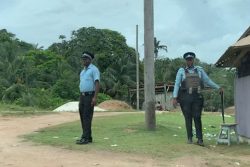Story and photos by Jeanna Pearson
Acres of canefields and tractors line the access roads of many villages on the West Bank of Demerara, but there is something different about La Retraite that causes villagers, especially the younger folks, to remain in the place of their birth.
After a long day of doing chores in her home, Carmen Sandbach would clamber up the “back steps” of her daughter’s house around 5pm to listen to the waves crashing against the seawall in her village. She would stay there for hours into the night, inhaling the cool evening breeze, until the sun goes down and the lights on the Habour Bridge are turned on. “That’s why I like La Retraite,” she said.
In the night the lights on the bridge are like “golden candle flies” dancing over the river—sometimes competing
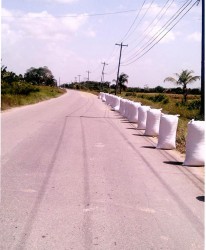
with the lights from ships. Most villagers would sit on their verandas to watch the sea at night and enjoy the solitude of the evening wind.
La Retraite, a small village of about 250 residents, is sandwiched between huge acres of cane fields in the west and the Demerara River on the east. It is about seven miles from Vreed-en-Hoop.


“I moved here with my grandmother on 28th May, 1966— two days after we gained independence—from my mother’s home. I was just a month old. I grew up here and raised my children here. I like it here…especially at nights…the lights are beautiful,” she said.
She said children who had played with her in the village playground were all grown up and building their own families. But over time the playground was neglected and people came and squatted on the land. “Now the children don’t have place to play…they would play on the road,” she said.
She recalled that her fondest memories as a child were centered around the long walk to school every morning with her friends. “School was school in those days…we could never go to school late because Miss Karen – I still remember her name – had a long line of children and she would take out her wild cane. Children were afraid of their teachers in those days. Now, teachers are puny and the children take advantage of them. But we had big strapping teachers.”
She said the village was very safe and cooperative. “We don’t have to frighten anything, we don’t have thieves…everybody lives as one…we ain’t get ‘black’ and ‘coolie’ here…”

The life of the village revolves around an old wooden church that was erected since the start of the village. “Everyone use to go to church on Sundays and in the week. It was and still is a pinnacle of the village. But
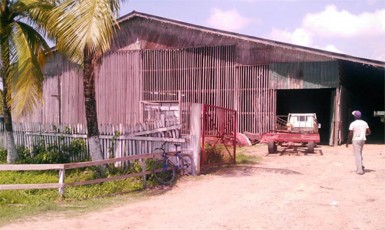
it use to function more back in the days,” said a tall slender woman. She was the daughter of the Pastor from the early 1980s and 1990s. “We use to have youth fellowships and everyone use to come out,” Esther Bobb said. Her father had passed away a few years ago after retiring from preaching. But Esther continued serving as member in the church. “People are busy now…even the children are busy. Most people work late or finish late from lessons…so the church is smaller now.”
Leaning over her porch, Esther recalled mixing tamarind in a plastic bag and calling out to her friends to leave for school. “We use to make tamarind down the road to school. We would mix it in a plastic bag, me and three other girls and we would go through the village and collect each other,” she said. “When we reach the

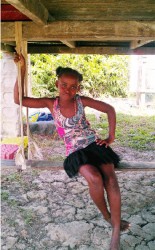
house
person’s house we would whistle or call their names,” she related, noting that they would walk to the La Retraite Primary School, which was at the very end of the village.
And when they returned home in the afternoon, they would play sal-out, tag and the hop-scotch on the road. “All the children would come out and play,” she said.
But as she grew old she developed a love for the river. “I like to watch the river in the afternoons…this village is nice for that…I like it for that,” she said. Esther also echoed Sandbach’s words about the people in the village. “I love the village because the East Indians and blacks live as one. If we need help they would stop and help you…we don’t have nothing like race here…we don’t watch each other by the colour of our skin.”
Nazamoon Hamid, a 72 year-old woman, said she moved to the village 42 years ago with her husband and six children. She said they leased a plot of land and built a small house to live in. “When we move here there wasn’t any canefield. It was a rice field and there was no access road…this road that they have here never existed. It was a mud dam. The only road it had was the road at the back, what we now call the old road,” she said.
“It is a very quiet place except for when the young boys get big music and make noise,” she said.
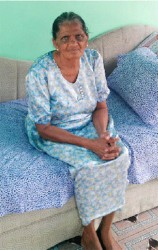
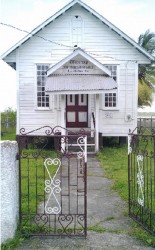
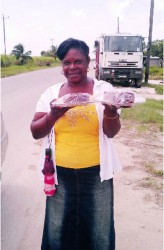
Some residents, however, complained of the village having no street lights or working telephone lines. “In my young days it had streetlights but as the years pass it all damage up and now when the night come and we see any strange body patrolling the road we would have to watch and worry because it could be a thief man,” said Helo Bissoon.
She said she lived in the village for over fifty years. “Me worked and watch my children grow and build a life here and build my future and I’m living good, but we need some lights on the roads and telephones.”
‘I glad if they put in street lights in the village because the road does be dark and thieves can come in the village and rob us,” said Beverly Marshall. She is a vegetable farmer, who has to provide for six children. She has been living as a widow for five years and said she found it hard. “The village is nice and quiet but we need telephone and street lights ’cause the road would be pitch black in the night.”
She said people in village had their telephones lines set up for the past three years but GT&T is yet to install a working system.
Residents also complained that a section of the sea defence was broken. Sandbach said a section of the wall cracked some three years ago and the Public Works Ministry had promised to fix it.
“They come and patch it up with mud and say they will fix it but they never come back. You know how much time we complain and call in to them? Now the salt water coming in and eating away at our land,” she lamented. She added that most of the drains are blocked “so the water does not get to drain off.”
Most of the villagers are cane cutters and teachers in other villages while the others seek work in the city. There are three small grocery shops but many residents shop at the Wales market on Friday. The Friday market is the biggest market day for most villages on the West Bank.







